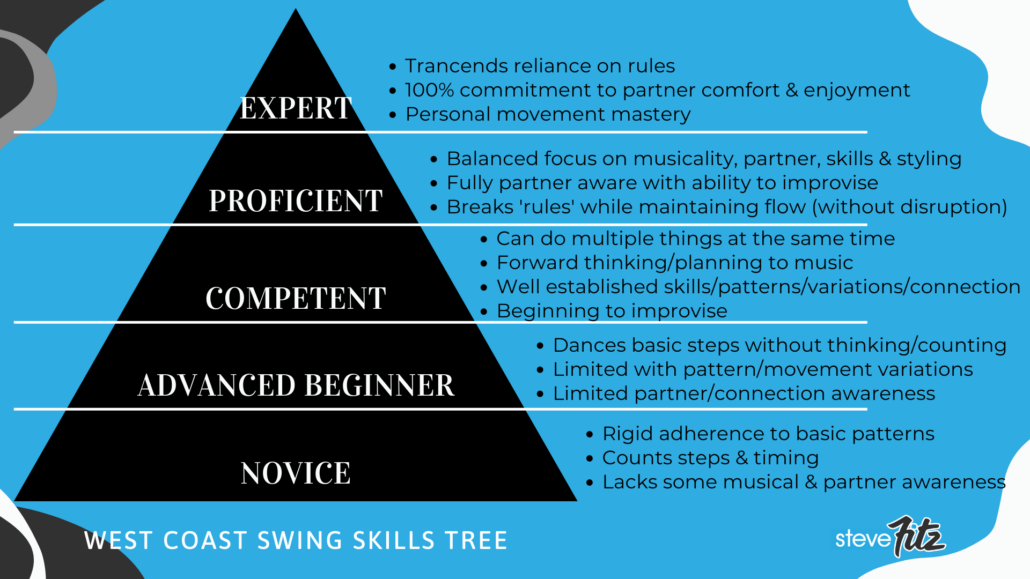West Coast Swing Skills Tree
When it comes to West Coast Swing, there are so many skills to learn and master.
To help you grow as a dancer (or teacher) I created the West Coast Swing (WCS) skills tree. This allows you to identify what skills you currently have and what you can focus on next to advance your skill set.

As a beginner, I used to ask ‘what to do next’ or ‘how do I learn this and that’… but it was rare to get a good answer as to what I could work on to improve.
Fortunately for me one of my teachers laid out a plan which I was able to follow for 6 months which helped me progress up the skills tree. This made me even more aware of the plight of so many other students who felt just like me.
West Coast Swing requires learning a lot of skills: Footwork, hand placement, movement, timing, patterns, partner connection, balance, rotations, frame, musicality, styling and so much more… Each layer of skill adds extra complexity and nuance… then change partners to someone who is a different height, weight, skill level and dances with a different style and you’re starting all over again!
As a result;
- Beginners can feel overwhelmed by the amount to learn or that it’s too difficult.
- Intermediate dancers wonder what skills they should learn next and often feel like they’re not progressing.
- Proficient and Expert dancers regularly teach above the skill level of their students, leaving students discouraged as it doesn’t help them at the current skill level. This frustrates the teachers because students “don’t get it”. Rinse & Repeat!
I believe it’s important for each of us, no matter where we are, to have a broader perspective. To place ourselves (and for teachers to be able to place others) on the skill tree.
Doing this helps individuals know what to train and practise so we become better West Coast Swing dancers. It also helps teachers know what to teach each student according to their skill level so they can successfully grow and become better dancers.
Everyone climbs the skill tree by learning, practising and mastering skills. That means time in class, time in private lessons, time watching others, time listening to music and time spent training solo. Without which, you simply can’t develop into a well rounded West Coast Swing dancer.
The Skills Track
There are 5 broad skill levels. These are;
- Novice
- Advanced Beginner
- Competent
- Proficient
- Expert
These skills and the Skills Tree have no affiliation with WSDC Rankings which are Newcomer, Novice, Intermediate, Advanced, All Star, Champion.
How to place yourself on the WCS Skills Tree
Using your best judgement, see where you fit on the skills tree according to your current ability.
Novice
- You currently have a rigid adherence to basic patterns
- You currently count steps and timing
- You lack some musical and partner awareness
Advanced Beginner
- You dance basic steps without thinking/counting
- You’re limited with pattern/movement variations
- You’re limited in your partner/connection awareness
Competent
- You can do multiple things at the same time
- You forward think/plan to music and hit breaks or style on lyrics regularly
- You have well established skills/patterns/variations and partner connection
- You are beginning to improvise and feel comfortable doing so
Proficient
- You have a balanced focus on musicality, partner, skills and styling
- You’re fully partner aware with ability to improvise (solo and together)
- You can break the ‘rules’ of the dance while maintaining flow (without disruption to your partner)
Expert
- You trancend reliance on rules
- 100% commitment to partner comfort and enjoyment
- You’ve got personal movement mastery
What to learn next in West Coast Swing
As any dancer who is wanting to grow in their ability and skill, you may be asking yourself what should you learn next?
The skills tree will show you the skills those above your current level have. This is a good guide as to what to work on next, however, ultimately you’re wanting to become an expert.
My suggestion is, to see what skills those above you on the skills tree have and aspire to learn all of them.
For example, if you’re a Novice on the skills tree, you can still train personal movement mastery at home on your own. That means practising skills such as spins, turns, walks, footwork drills, balance and so on. These skills are important on every skill level.
Having a 100% commitment to partner comfort and enjoyment is also a great trait and mindset to have, no matter where you are on the skills tree.
I hope the West Coast Swing Skills Tree helps you self-assess and gives you an idea of what skills to work on developing next.
At the end of the day, it’s all about your personal enjoyment. Becoming a better dancer will increase your enjoyment and the enjoyment your dance parters have when dancing with you.
